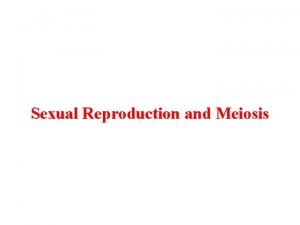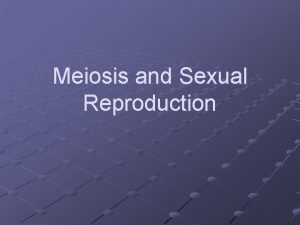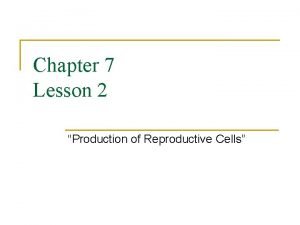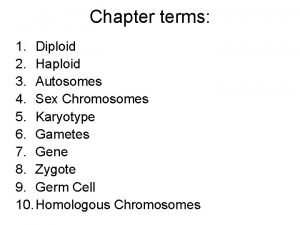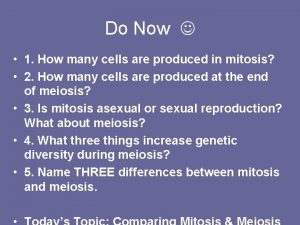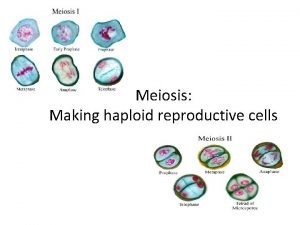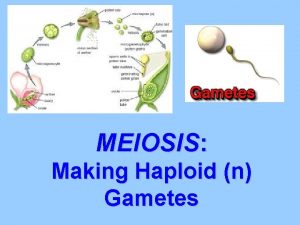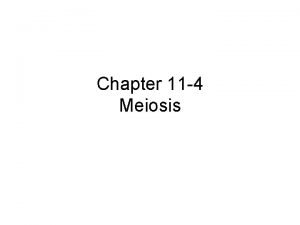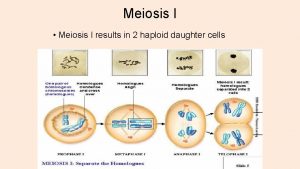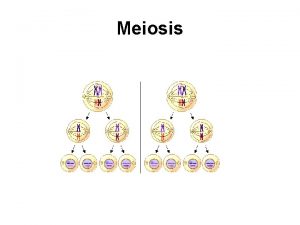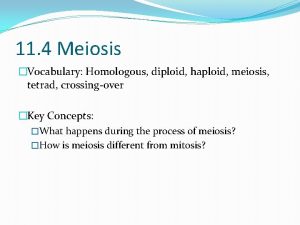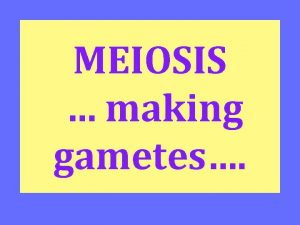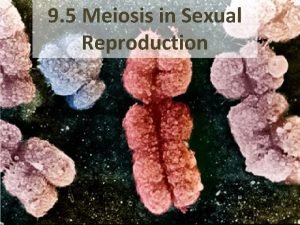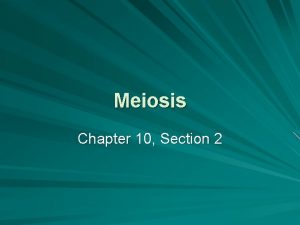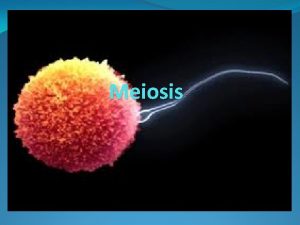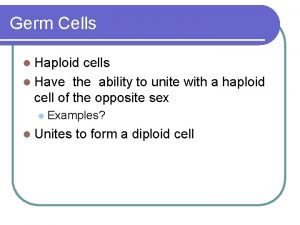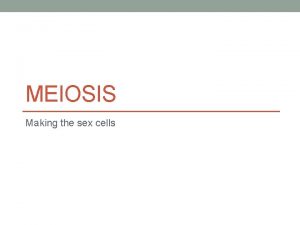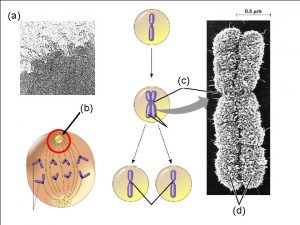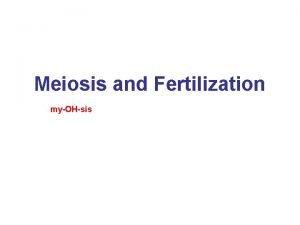1 meiosis 2 Making haploid cells 3 Most























- Slides: 23

1 meiosis

2

Making haploid cells 3 • Most body cells are diploid (2 n) and undergo mitosis. • Gamete – reproductive cell is a haploid (n). • In humans these are eggs and sperms. • The gametes are found in organisms which reproduce sexually. • Then fertilization occurs when two gametes fuse to form the first cell of an organism.

4 23 23 46 The gametes form from germ cells through a process known as meiosis

meiosis Two stage form of nuclear division in which the number of chromosomes is halved Meiosis I – first division – reduces the number of chromosomes by half 5

Prophase I is the st 1 stage 6 • Chromosomes condense • The homologous chromosomes pair up. • Matching pairs of chromosomes – one from mom and one from dad. • The nuclear membrane disappears. • Spindle fibers form.

Crossing over occurs • Exchange of DNA segments on homologous chromosomes. • Creates unique chromosomes with each containing genetic material from each parent. • Contributes to evolution and adaptation 7

8

Metaphase I Homologous pairs of chromosomes move to the middle of the cell 9

Anaphase I Homologous chromosomes are separated (pulled apart) by the spindle fibers. 10

Telophase I • 2 diploid cells form • Spindle fibers disappear 11

Meiosis II 12 2 nd division that separates copies of the chromosome CHROMOSOMES DO NOT DUPLICATE!

Prophase II • Spindle fibers form • Nuclear membrane disappears • NO CROSSING OVER 13

Metaphase II Chromosomes line up in the middle of the cell 14

Anaphase II Sister chromatids are separated 15

Telophase II • Nucleus reforms • Chromosomes uncoil forming chromatin • Spindle fibers disappear 16

Cytokinesis Cell division Cytoplasm pinches in half Haploid: 23 Chromosomes 17

Results of meiosis. 18 • 4 unique haploid cells • In males – 4 sperms • In females – 1 egg and 3 polar bodies (non-reproductive cell)

19

20

Pg 344 21

22

Compare Mitosis & Meiosis: pg 396 - 397 23 Mitosis: Meiosis: Same: Pg 345 - 349 Pg 394 - 395
 Two haploid cells
Two haploid cells Anapjase
Anapjase Produces diploid cells
Produces diploid cells Homologous chromosome vs sister chromatid
Homologous chromosome vs sister chromatid Telophase def
Telophase def Meiosis i vs meiosis ii
Meiosis i vs meiosis ii Meiosis and mitosis
Meiosis and mitosis Crossing over occurs during:
Crossing over occurs during: Difference between meiosis 1 and meiosis 2
Difference between meiosis 1 and meiosis 2 Chapter 10 section 1: meiosis
Chapter 10 section 1: meiosis Chapter 10 meiosis 1 and meiosis 2 answer key
Chapter 10 meiosis 1 and meiosis 2 answer key Telophase
Telophase Are diploid cells produced in meiosis
Are diploid cells produced in meiosis How many cells are produced in meiosis? *
How many cells are produced in meiosis? * Meiosis
Meiosis Whats a gamete
Whats a gamete Metaphase 2
Metaphase 2 Sphenoid paranasal sinus
Sphenoid paranasal sinus Transport maximum
Transport maximum Pineal gland
Pineal gland Gametic cells vs somatic cells
Gametic cells vs somatic cells Somatic cells vs germ cells
Somatic cells vs germ cells Red blood cells and white blood cells difference
Red blood cells and white blood cells difference Prokaryotic versus eukaryotic
Prokaryotic versus eukaryotic


